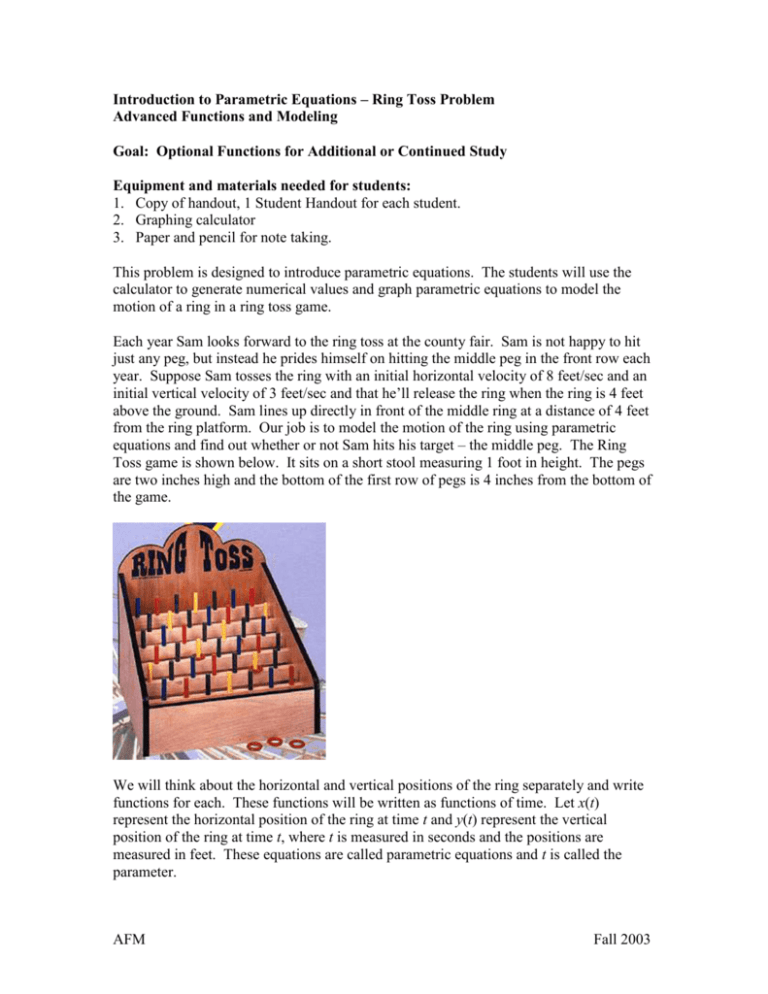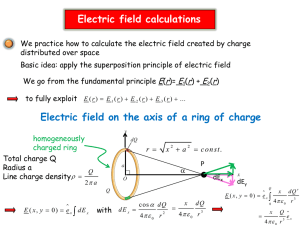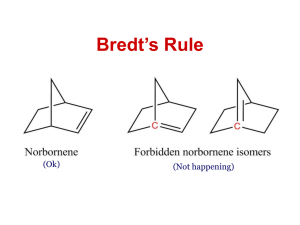Introduction to Parametric Equations – Ring Toss Problem
advertisement

Introduction to Parametric Equations – Ring Toss Problem Advanced Functions and Modeling Goal: Optional Functions for Additional or Continued Study Equipment and materials needed for students: 1. Copy of handout, 1 Student Handout for each student. 2. Graphing calculator 3. Paper and pencil for note taking. This problem is designed to introduce parametric equations. The students will use the calculator to generate numerical values and graph parametric equations to model the motion of a ring in a ring toss game. Each year Sam looks forward to the ring toss at the county fair. Sam is not happy to hit just any peg, but instead he prides himself on hitting the middle peg in the front row each year. Suppose Sam tosses the ring with an initial horizontal velocity of 8 feet/sec and an initial vertical velocity of 3 feet/sec and that he’ll release the ring when the ring is 4 feet above the ground. Sam lines up directly in front of the middle ring at a distance of 4 feet from the ring platform. Our job is to model the motion of the ring using parametric equations and find out whether or not Sam hits his target – the middle peg. The Ring Toss game is shown below. It sits on a short stool measuring 1 foot in height. The pegs are two inches high and the bottom of the first row of pegs is 4 inches from the bottom of the game. We will think about the horizontal and vertical positions of the ring separately and write functions for each. These functions will be written as functions of time. Let x(t) represent the horizontal position of the ring at time t and y(t) represent the vertical position of the ring at time t, where t is measured in seconds and the positions are measured in feet. These equations are called parametric equations and t is called the parameter. AFM Fall 2003 Consider the horizontal position first. Since we know that Sam tosses the ring with a horizontal velocity of 8 ft/sec, our function is x(t ) 8t . Now for the vertical position, we know that the vertical position of the ring will be given by y(t)=- 12 gt 2 v0t y0 , where g is the acceleration due to gravity (32 ft / sec2 ), v0 is the initial velocity and y0 is the initial height of the ring when Sam releases it. So we have, y(t) = -16t 2 +3t+4 . Using these equations, we can use our calculator in parametric mode to model the motion of the ring. On the calculator hit the Mode Key, arrow down to where you have Func Par Pol Seq Highlight Par and hit Enter. Now hit the Y= key. We see the following: To type our equations into the calculator, we’ll hit he X,T, , n key when we want a t in the equation. Your equations should look like this: To look at the numerical values for x(t) and y(t), hit the TBLSET key (2nd WINDOW) . Use the following settings: Now hit the TABLE key (2nd GRAPH) and you should see the following: AFM Fall 2003 Have the students think carefully about these values and how they represent the horizontal and vertical position of the ring at time t. To graph these equations, we need to first choose a good viewing window. Hit the Window key and set your variables as follows: Scroll down and then set your remaining variables as follows: Notice we have some “new” things to consider when we graph a parametric equation. We set the Tstep to 0.1 since we want the calculator to graph the position of the ring for each 1/10 of a second. The Tmin = 0 because we start at time t = 0 and the Tmax = 5 because we want to plot the position of the ring for 5 seconds. The Xmin, Xmax, Xscl, Ymin, Ymax, and Yscl were chosen based on the table values. Now hit graph and you should see the following: If you hit the TRACE key and scroll left and right , you will see the x-value, y-value and t-value at each point. AFM Fall 2003 In order to find out whether or not Sam hits his target, we need to calculate the position of the top of the target peg. The game is 4 feet from Sam and the game is on the one foot stool. The peg measures 2 inches and is located 4 inches from the bottom of the game. This information indicates that the top of the peg should be at the coordinates (4, 1.5). If we trace on our graph to the point where x = 4, we see that the y-value is 1.5 when t = 0.5, so Sam has hit his mark again! Introduction to Parametric Equations – Ring Toss Problem Advanced Functions and Modeling Student Handout Each year Sam looks forward to the ring toss at the county fair. Sam is not happy to hit just any peg, but instead he prides himself on hitting the middle peg in the front row each year. Suppose Sam tosses the ring with an initial horizontal velocity of 8 feet/sec and an initial vertical velocity of 3 feet/sec and that he’ll release the ring when the ring is 4 feet above the ground. Sam lines up directly in front of the middle ring at a distance of 4 feet from the ring platform. Our job is to model the motion of the ring using parametric equations and find out whether or not Sam hits his target – the middle peg. The Ring Toss game is shown below. It sits on a short stool measuring 1 foot in height. The pegs are two inches high and the bottom of the first row of pegs is 4 inches from the bottom of the game. We will think about the horizontal and vertical positions of the ring separately and write functions for each. These functions will be written as functions of time. Let x(t) represent the horizontal position of the ring at time t and y(t) represent the vertical position of the ring at time t, where t is measured in seconds and the positions are measured in feet. These equations are called parametric equations and t is called the parameter. AFM Fall 2003 Consider the horizontal position first. Since we know that Sam tosses the ring with a horizontal velocity of 8 ft/sec, our function is x(t ) 8t . Now for the vertical position, we know that the vertical position of the ring will be given by y(t)=- 12 gt 2 v0t y0 , where g is the acceleration due to gravity (32 ft / sec2 ), v0 is the initial velocity and y0 is the initial height of the ring when Sam releases it. So we have, y(t) = -16t 2 +3t+4 . 1. Using your calculator in parametric mode, type these equations and generate a table of values for the horizontal and vertical position of the ring for 0.7 seconds. Use a step size of 0.1. Record those values in the table below: t x(t) y(t) 0 0 4 0.1 0.2 2. Sketch a graph of the ring’s position for the reasonable values in your table. Lable your axes carefully. Label the points at time t = 0, t = 0.3 and t = 0.5. 3. Using your parametric equations, determine whether or not Sam will hit his target peg. Explain your reasoning. AFM Fall 2003









